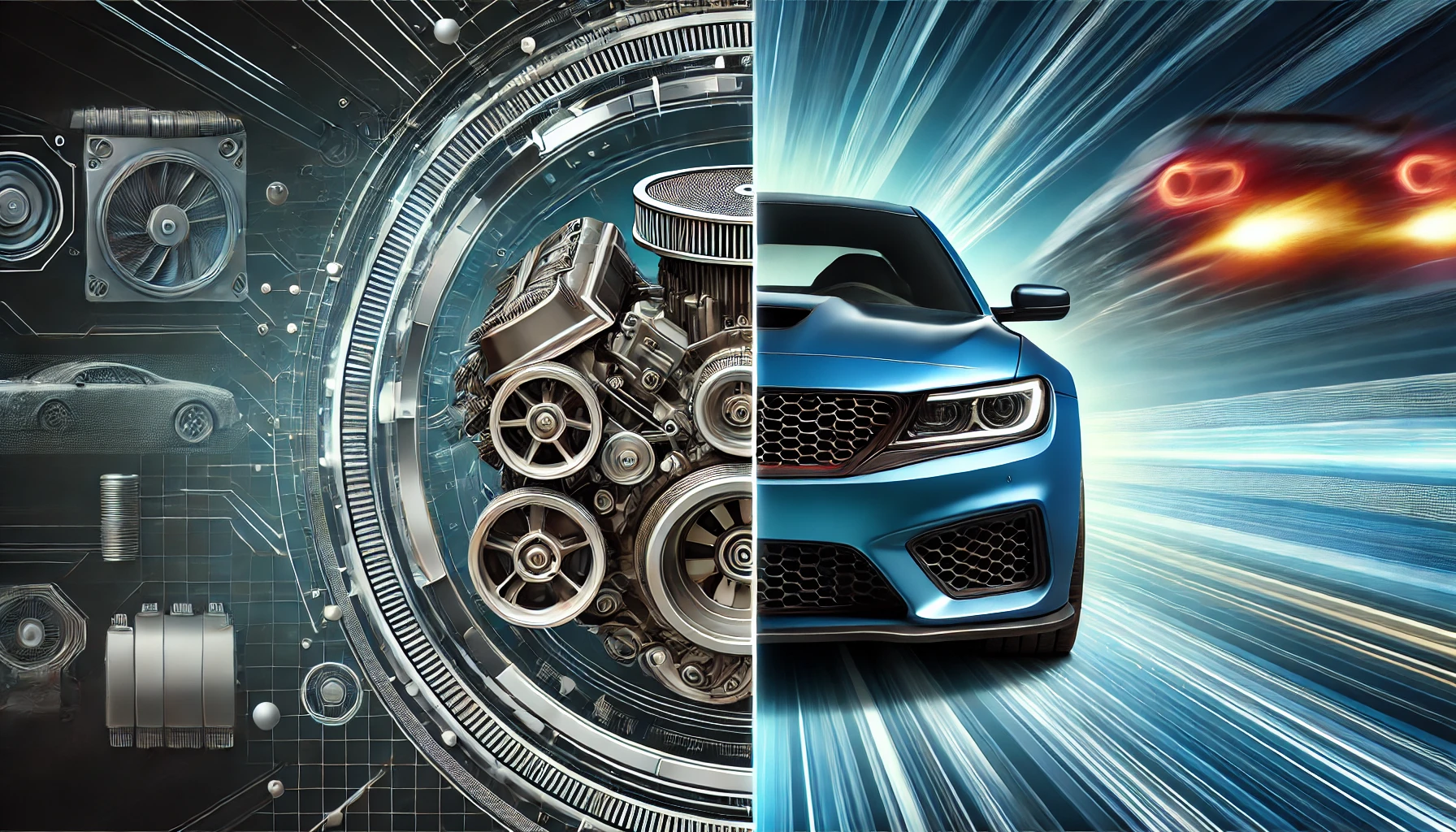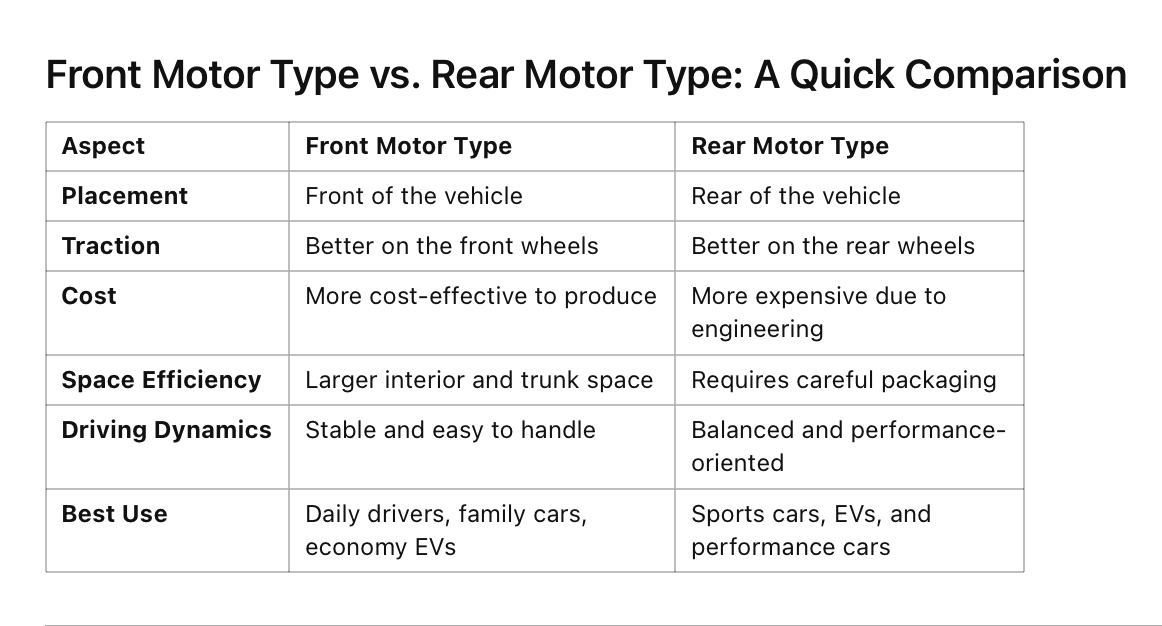Front Motor Type v/s Rear Motor Type in Cars
Last Updated At: 2025-12-12 Author: Sarah
[Car Tech Knowledge/ XNmotors]
When purchasing a car, understanding how and where the engine or motor is positioned can significantly impact your driving experience. Two key terms you’ll frequently encounter are “Front Motor Type” and “Rear Motor Type.” These terms describe where the primary power unit—be it an internal combustion engine (ICE) or an electric motor—is placed in a vehicle.
Both configurations have their unique advantages and are designed to suit different driving conditions, styles, and vehicle needs. Let’s break down what these terms mean and how they affect car performance.

Image Source: AI generated
Front Motor Type
In a Front Motor Type car, the engine or electric motor is placed in the front portion of the vehicle, typically above or near the front axle.
Key Characteristics:
• Most common configuration in modern vehicles.
• Usually combined with Front-Wheel Drive (FWD) or, in some cases, All-Wheel Drive (AWD) systems.
• Suitable for both internal combustion engines and electric motors.
Advantages of Front Motor Type:
• Space Efficiency: Placing the motor or engine in the front allows for a larger passenger cabin and trunk space. This is ideal for compact and family-oriented vehicles.
• Cost-Effective: Front motor setups are simpler and cheaper to produce, reducing manufacturing costs and overall vehicle prices.
• Stability: The front motor improves weight distribution over the front wheels, enhancing traction and steering control in standard road conditions, especially on wet or slippery surfaces.
• Fuel Efficiency: These vehicles tend to be more efficient due to reduced drivetrain losses.
Best Use Cases:
• City cars, hatchbacks, and sedans.
• Economy vehicles designed for day-to-day commuting.
• Front-wheel-drive electric cars, where compact motor placement frees up rear space.
Popular Front Motor Type Cars:
• Toyota Corolla
• Honda Civic
• Volkswagen Golf
• Most front-wheel-drive electric vehicles (like the Nissan Leaf).
Rear Motor Type
In a Rear Motor Type car, the motor or engine is positioned in the rear section of the vehicle, typically behind the rear axle. While historically less common, rear motor configurations have gained popularity with the rise of electric vehicles (EVs).
Key Characteristics:
• Often paired with Rear-Wheel Drive (RWD) systems, though some may incorporate AWD.
• More common in high-performance sports cars and modern electric vehicles.
Advantages of Rear Motor Type:
• Improved Traction: The weight of the motor over the rear wheels enhances traction during acceleration, particularly in RWD cars.
• Balanced Handling: Rear motor cars often provide better balance and dynamic performance, as the weight distribution allows for sharper cornering and better control.
• Enhanced Driving Experience: Sports cars with rear motors deliver a more engaging and responsive driving experience.
• EV Compatibility: Electric motors are compact and lightweight, making the rear placement ideal for packaging and improving vehicle dynamics without compromising passenger space.
Best Use Cases:
• High-performance sports cars and luxury vehicles.
• Electric vehicles where rear motor placement balances weight distribution.
• Off-road vehicles that require excellent rear-wheel traction.
Popular Rear Motor Type Cars:
• Porsche 911 (classic example with a rear-engine setup).
• Tesla Model 3 (base RWD version).
• Volkswagen ID.3 and ID.4 (electric cars with rear motor designs).
Front Motor Type vs. Rear Motor Type: A Quick Comparison

Which One Should You Choose?
The choice between Front Motor Type and Rear Motor Type largely depends on your driving needs:
• Front Motor Type cars are ideal for daily commuting, fuel efficiency, and family use. They are reliable, affordable, and handle well in standard road conditions.
• Rear Motor Type cars excel in performance, balance, and dynamic driving. If you value handling, acceleration, or EV technology, a rear motor configuration is worth considering.
Conclusion
Both Front Motor Type and Rear Motor Type vehicles bring distinct advantages to the table. As electric vehicles continue to evolve, rear motor placements are becoming increasingly popular due to their compatibility with modern EV designs. Whether you prioritize efficiency, performance, or space, understanding these configurations will help you make an informed choice when purchasing your next vehicle.
( Article / XNmotors Sarah )
Comments
No comments yet. Be the first one to comment.